#S.XIII
Text

The only original Spad XIII in airworthy condition in the world seen at La Ferté-Alais Airfield, France
#SPAD#S.XIII#French Fighter#WW1 Fighter#Biplane#fighter aircraft#plane#airfield#Spad S.XIII#vintage aircraft#rare aircraft
139 notes
·
View notes
Text
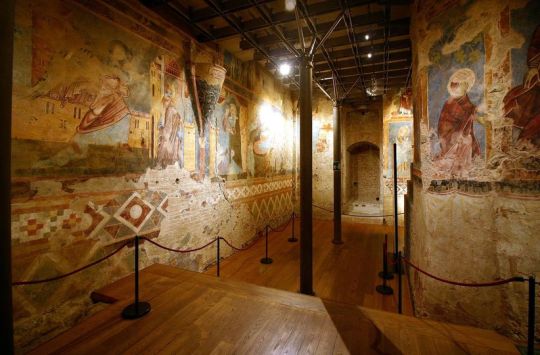
(Español / English / Italiano)
La cripta de la catedral de Siena es un complejo arqueológico medieval situado debajo de la catedral y solo redescubierto en 1999. Contiene una serie de frescos del siglo XIII que fueron sellados unas décadas después de ser pintados, por lo que ahora se presentan en colores extraordinariamente brillantes, haciéndolos casi únicos en la historia del arte. El nombre 'cripta' es puramente evocador: se cree que hay otra cripta en la catedral, la original, bajo la cúpula, en habitaciones que sin embargo aún son inaccesibles hoy debido al riesgo de problemas estáticos.
*****
The crypt of the Cathedral of Siena is a medieval archaeological complex located beneath the cathedral and only rediscovered in 1999. It contains a series of 13th-century frescoes that were sealed a few decades after they were painted, which is why they present themselves today in extraordinarily brilliant colours, making them almost unique in the history of art. The name 'crypt' is purely evocative: it is believed that there is another crypt in the cathedral, the original one, under the dome, in rooms that are however still inaccessible today due to the risk of static problems.
*****
La cripta del Duomo di Siena è un complesso di archeologia medievale, situato sotto la cattedrale e riscoperto solo nel 1999. Contiene una serie di affreschi duecenteschi che furono sigillati pochi decenni dopo la loro stesura, per questo si presentano oggi con colori straordinariamente brillanti, facendone pressoché un unicum nella storia dell'arte. Il nome di "cripta" è puramente evocativo: si ritiene che esista un'altra cripta della cattedrale, quella originaria, sotto la cupola, in locali tuttavia ancora oggi inaccessibili per il rischio di problemi di statica.
fuente: Musei Italiani
#cripta medieval#affreschi#XIII secolo#s.XIII#13th century#middle ages#edad media#medievo#13th-century frescoes#frescos#siglo XIII
0 notes
Text
Saft & Almann Motorbau 99 - "An Engineer's Fighter"
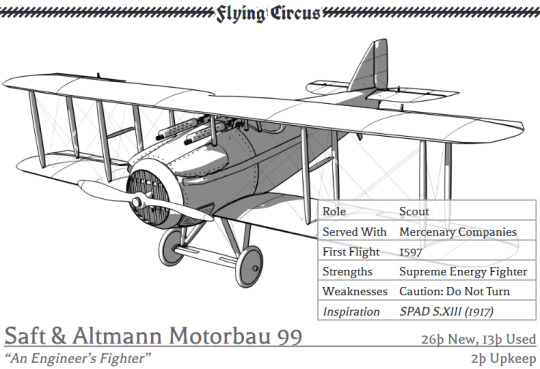
Role: Scout
Served With: Mercenary Companies
First Flight: 1597
Strengths: Supreme Energy Fighter
Weaknesses: Caution- Do Not Turn
Inspiration: SPAD S.XIII (1917)
Description:
SAM was an engine manufacturer in Eisenfluss, a Free City in Daimler, building the popular Kurier V8 series for other nations. They also produced custom aircraft for export, militia forces, and eventually the Alliance of Free Cities.
The SAM 99 represented the ultimate evolution of their scouts. It has many clever innovations, including a high speed propeller, internal bomb bay, and razor-thin multibay wings. The weight of the aircraft and staid, careful aerodynamics rendered it a poor turning fighter, but the geared engine allowed it to outclimb, outdive or outrun nearly anything else in the air.
If is often said that a disciplined SAM 99 pilot is almost invincible, but a reckless SAM 99 pilot will ruin a beautiful aircraft as they die.
4 notes
·
View notes
Photo
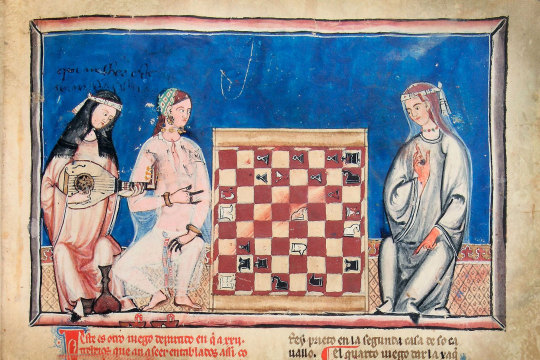
Una "Auïda’’ (tañedora de cuerdas) en el Libro de los Juegos. S.XIII.
#manuscript#Medieval Age#xiii century#la henna en sus manos...los tocados....la guitarrista con el laúd andalusí...#just girls chillin
86 notes
·
View notes
Text
Tecnología y globalización
La Geria, Lanzarote
Esto de la primera foto lo trazó un arquitecto técnico, y lo hicieron unos chicos colombianos que trabajan la piedra, y lo hicieron este año 2024. Nada que objetar, solo ofrezco el dato
La segunda y tercera foto es el mismo sistema del cultivo de la vid en esa zona pero hecho antiguamente por la gente de la isla
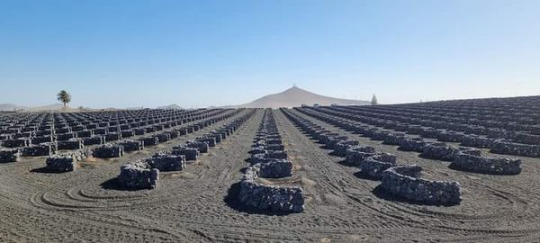

Antiguamente era así. Ya las parras en el fondo de los hoyos estaban protegidas del viento, y se podaban de forma que nunca sobresaliesen de aquellos hoyos hechos para acercarse a la tierra fértil que había sido cubierta por una capa de picón esparcido por los volcanes del S.XIII, y los muros en media luna evitaban que se metiera de nuevo esa arena volcánica en los hoyos. Además, también retienen el sereno nocturno y esa humedad, al convertirse en goterones se introduce por la capa de arena hasta la tierra donde está la raíz. Pero esa zona nueva que hicieron, la de la primera foto, la capa de arena es mucho más fina que la que cubrieron los volcanes, por lo que ahora están de decoración, y protegen del viento también
2 notes
·
View notes
Text

Trata de no resistirte a los cambios que vienen en camino.
En su lugar, deja que la vida viva a través de ti.
Y no te preocupes de que tu vida se esté poniendo de revés.
¿Cómo sabes que el lado al que estás acostumbrado es mejor que el que ha de venir?
RUMI teòleg islàmic d’origen persa s.XIII
5 notes
·
View notes
Text
A.i story concept 11
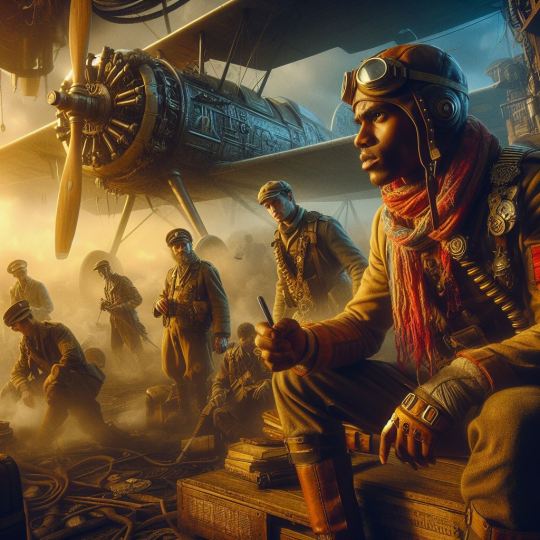
It was a sunny day in 1918, and Pierre was flying his SPAD S.XIII biplane over the Western Front. He was on a mission to intercept a German reconnaissance plane that had been spotted near the Allied lines. He scanned the skies for any sign of the enemy, but saw nothing but blue.
Suddenly, he felt a jolt in his cockpit, and his instruments went haywire. He looked around, and saw a bright flash of light enveloping his plane. He felt a surge of nausea and dizziness, and then everything went black.
When he regained consciousness, he found himself still in his plane, but in a different place. He looked down, and saw a landscape that he did not recognize. There were fields, forests, and villages, but they looked different from the ones he knew. He saw roads, railways, and bridges, but they were more modern and advanced. He saw cars, trucks, and tanks, but they were not the ones he had seen before.
He realized that he had somehow been transported to another time. He checked his compass, and saw that he was flying over France, but he did not know when. He tried to contact his base, but his radio was silent. He felt a pang of fear and confusion, and wondered what he should do.
He decided to look for a friendly airfield, and hope that someone could help him. He flew lower, and searched for any signs of the French flag or the Allied insignia. He avoided the roads and railways, as he saw vehicles with strange symbols and markings. He guessed that they belonged to the enemy, but he did not know who they were.
He flew for a while, and then he saw something that made his blood run cold. He saw a large, metal bird, flying in the opposite direction. It was much bigger and faster than his biplane, and it had a sleek, streamlined shape. It had a cross painted on its side, and a swastika on its tail. He recognized it as a German plane, but he had never seen anything like it before.
He realized that he had encountered a fighter jet, a weapon of the future. He wondered how the Germans had developed such a thing, and what it meant for the war. He felt a surge of anger and patriotism, and decided to attack it. He turned his plane around, and chased after the jet. He fired his machine guns, but the jet was too fast and agile. He could not hit it, and soon it was out of his range.
He cursed, and decided to give up. He knew that he was no match for the jet, and that he had wasted his ammunition. He turned his plane back, and looked for a safe place to land. He hoped that he could find some friendly forces, and explain his situation. He hoped that he could find a way back to his own time, and rejoin his comrades. He hoped that he could survive this strange and dangerous adventure.
Pierre flew for a long time, looking for a friendly airfield. He saw many towns and villages, but they all looked occupied by the enemy. He saw flags with the swastika, and soldiers wearing gray uniforms. He saw people wearing yellow stars, and trucks carrying them away. He saw smoke and fire, and heard explosions and gunshots. He felt a mix of horror and pity, and wondered what had happened to his beloved France.
He checked his fuel gauge, and saw that it was almost empty. He knew that he had to land soon, or he would crash. He looked for a suitable spot, and saw a large, wooded area. He decided to try his luck there, and hoped that he could find some shelter and help.
He descended slowly, and maneuvered his plane through the trees. He saw a clearing, and aimed for it. He touched down, and braked hard. He felt his plane skid and bounce, and then stop. He breathed a sigh of relief, and turned off his engine. He looked around, and saw that he was in a secluded and quiet place. He saw no signs of life, except for some birds and squirrels.
He got out of his plane, and checked it for damage. He saw that it was intact, but dirty and scratched. He decided to hide it, and cover it with some branches and leaves. He hoped that no one would find it, and that he could come back to it later.
He took his pistol, his map, and his compass, and put them in his pockets. He also took his leather jacket, his goggles, and his scarf, and wore them. He felt cold, and realized that it was winter. He wondered how long he had been unconscious, and how far he had traveled in time.
He looked at his map, and tried to figure out where he was. He saw that he was near the border of France and Belgium, in a region called Ardennes. He remembered that it was a hilly and forested area, and that it had been the site of some battles in the past. He wondered if it was still a war zone, and if he could find some allies there.
He decided to head north, and look for a road or a village. He hoped that he could find some friendly forces, or at least some civilians who could help him. He walked through the woods, and followed his compass. He was careful to avoid any noise or movement, and to stay hidden from any potential enemies.
He walked for a long time, and then he saw a house. It was a small, stone cottage, with a thatched roof and a chimney. It looked old and abandoned, and had no signs of occupation. He decided to check it out, and see if he could find some shelter and food.
He approached the house, and looked for any traps or alarms. He saw none, and decided to enter. He opened the door, and stepped inside. He saw a living room, with a fireplace, a sofa, and a table. He saw a kitchen, with a stove, a sink, and a cupboard. He saw a bedroom, with a bed, a closet, and a dresser. He saw a bathroom, with a toilet, a shower, and a mirror. He saw that the house was dusty and dirty, and that it had been looted and vandalized. He saw that the furniture was broken, and that the walls were stained with blood and graffiti.
He felt a chill, and realized that the house had been the scene of a crime. He wondered who had lived there, and what had happened to them. He felt a pang of sadness, and decided to respect their memory. He decided to stay in the house, and rest for a while. He hoped that no one would come, and that he would be safe there. He hoped that he could find a way back to his own time, and rejoin his comrades. He hoped that he could survive this strange and dangerous adventure.
Pierre made a fire in the fireplace, and warmed himself up. He found some canned food and water in the cupboard, and ate them. He felt hungry and thirsty, and realized that he had not eaten or drunk anything since he had left his base. He wondered how his comrades were doing, and if they were worried about him.
He decided to sleep in the bed, and hope that it was clean and comfortable. He took off his jacket, his goggles, and his scarf, and laid them on the dresser. He kept his pistol, his map, and his compass, and put them under his pillow. He got into the bed, and pulled the blanket over him. He felt tired and exhausted, and fell asleep quickly.
He had a restless night, and dreamed of his past and his future. He dreamed of his family, his friends, and his girlfriend. He dreamed of his childhood, his school, and his hobbies. He dreamed of his enlistment, his training, and his missions. He dreamed of his plane, his enemies, and his allies. He dreamed of his time travel, his adventure, and his fate.
He woke up in the morning, and felt a headache and a soreness. He looked at the window, and saw that it was still dark. He checked his watch, and saw that it was 6:00 a.m. He decided to get up, and prepare for his departure. He hoped that he could find a way back to his own time, and rejoin his comrades.
He got out of the bed, and put on his jacket, his goggles, and his scarf. He took his pistol, his map, and his compass, and put them in his pockets. He went to the kitchen, and looked for some more food and water. He found none, and decided to leave. He hoped that he could find some on his way.
He went to the living room, and looked at the fireplace. He saw that the fire had died down, and that there was only ash and smoke. He decided to put it out, and prevent any fire hazard. He took a bucket, and filled it with water from the sink. He poured it over the fireplace, and heard a hiss and a sizzle. He saw that the fire was extinguished, and that there was no more smoke.
He went to the door, and opened it. He stepped outside, and felt a cold breeze. He saw that it was snowing, and that the ground was covered with white. He saw that his plane was still hidden, and that no one had found it. He decided to leave it there, and hope that he could come back to it later.
He looked around, and saw that the house was surrounded by trees. He saw that there was a road nearby, and that it led to a village. He decided to follow it, and look for some help. He walked towards the road, and kept an eye on his surroundings.
He reached the road, and saw that it was empty and quiet. He saw no cars, no trucks, no tanks, no planes, no jets. He saw no soldiers, no civilians, no allies, no enemies. He saw no signs of life, except for some footprints and tire tracks. He wondered where everyone was, and what was going on.
He decided to walk along the road, and head north. He hoped that he could find some friendly forces, or at least some civilians who could help him. He walked for a while, and then he heard something. He heard a rumble, a roar, and a clank. He heard voices, shouts, and commands. He heard guns, rifles, and grenades. He heard a battle, a fight, and a war.
He looked ahead, and saw a patrol. He saw a group of soldiers, wearing gray uniforms and helmets. He saw a vehicle, with a cross and a swastika. He saw a machine gun, a cannon, and a rocket launcher. He saw a German patrol, and realized that he was in trouble.
He quickly hid behind a tree, and hoped that they would not see him. He watched them as they approached, and tried to figure out what they were doing. He saw that they were armed and alert, and that they were looking for something. He saw that they were talking and gesturing, and that they were angry and frustrated. He saw that they were searching for someone, and that they were not happy.
He wondered who they were looking for, and why. He wondered if they were looking for him, and how. He wondered if they had seen his plane, and what. He wondered if they had seen his fire, and when. He wondered if they had seen his tracks, and where. He wondered if they had seen him, and how.
He felt a surge of fear and adrenaline, and decided to act. He had two options: he could either run or fight. He weighed the pros and cons, and made his choice. He decided to run, and hope that he could escape. He knew that he was outnumbered and outgunned, and that he had no chance of winning. He knew that he had to save his life, and his plane. He knew that he had to find a way back to his own time, and rejoin his comrades.
He waited for the right moment, and then he ran. He ran as fast as he could, and as far as he could. He ran away from the patrol, and away from the road. He ran towards the woods, and towards his plane. He ran for his life, and for his fate.
Pierre ran through the woods, dodging the trees and the branches. He heard the patrol behind him, chasing him and shooting at him. He heard bullets whizzing past him, and hitting the ground and the trees. He felt his heart pounding, and his breath panting. He felt his legs burning, and his feet hurting. He felt his fear growing, and his hope fading.
He ran for a long time, and then he saw a clearing. He saw a camp, with tents, trucks, and guns. He saw people, wearing civilian clothes and berets. He saw flags, with the tricolor and the cross. He saw a rebel camp, and realized that he had found some allies.
He ran towards the camp, and hoped that they would help him. He shouted in French, and asked for their assistance. He saw them looking at him, and reacting to his presence. He saw some of them welcoming him, and some of them aiming at him. He saw some of them recognizing him, and some of them doubting him. He saw some of them cheering him, and some of them cursing him.
He reached the camp, and stopped. He saw a man, wearing a leather jacket and a red scarf. He saw a woman, wearing a green dress and a blue hat. He saw a boy, wearing a brown shirt and a black cap. He saw a leader, a lieutenant, and a scout. He saw the rebels, and realized that they were the Resistance.
He greeted them, and introduced himself. He told them his name, his rank, and his unit. He told them his story, his mission, and his situation. He told them the truth, the whole truth, and nothing but the truth.
They listened to him, and evaluated him. They asked him questions, and verified his answers. They checked his plane, his pistol, and his papers. They tested his knowledge, his loyalty, and his courage. They judged him, and decided his fate.
They accepted him, and welcomed him. They told him their names, their roles, and their goals. They told him their story, their struggle, and their plan. They told him their secrets, their allies, and their enemies. They trusted him, and offered him a chance.
They invited him, and joined him. They gave him food, water, and clothes. They gave him shelter, medicine, and weapons. They gave him information, instructions, and orders. They gave him a mission, a role, and a purpose.
They asked him, and persuaded him. They asked him to help them, and to fight with them. They asked him to spy on the enemy, and to sabotage their operations. They asked him to fly his plane, and to bomb their targets. They asked him to join the Resistance, and to save France.
He agreed, and thanked them. He agreed to help them, and to fight with them. He agreed to spy on the enemy, and to sabotage their operations. He agreed to fly his plane, and to bomb their targets. He agreed to join the Resistance, and to save France.
He felt a surge of gratitude and excitement, and decided to act. He had a new option: he could either stay or go. He weighed the pros and cons, and made his choice. He decided to stay, and hope that he could make a difference. He knew that he was still lost and alone, and that he had no way back to his own time. He knew that he had to survive this war, and this adventure. He knew that he had to find a way to his own time, and rejoin his comrades.
He waited for the right moment, and then he acted. He acted as fast as he could, and as well as he could. He acted with the rebels, and with the Resistance. He acted for his life, and for his fate.
0 notes
Text
𝓗𝓲𝓼𝓽𝓸𝓻𝓲𝓪
Kutná Hora es una ciudad que se sitúa a 1 hora de Praga, se la conoce como la “Ciudad de la Plata”. Durante su momento de esplendor, gran parte de toda la plata extraída y manejada en Europa salía de sus minas. Incluso llegó a competir con Praga en poder e influencia.
•
Algunos de los motivos de la superpoblación del cementerio fueron los siguientes:
- En el s.XIII, un monje esparció tierra traída del Gólgota. A partir de ello, la gente quería ser enterrada ahí porque lo consideraban Tierra Santa.
- Peste negra en el s.XIV
- Guerras Husitas en el s.XV
👉🏼 El tallista František Rint fue contratado por la familia Schwarzenberg, quienes adquirieron el territorio a finales del s.XVIII.
🚂Se puede llegar fácilmente en tren desde Praga, se sale desde la estación central de trenes (al lado de la plaza de Wenceslao).
El osario se sitúa en un barrio llamado Sedlec, la entrada cuesta 160kc (6€ aprox).
Os recomiendo que primero visitéis el osario y después recorráis el casco antiguo de Kutná Hora. Allí podréis ver, entre otros monumentos, la Catedral de Santa Bárbara, el antiguo Colegio de los Jesuitas y la Corte Italiana.
•
Es una ciudad realmente bonita, merece la pena visitarla y conocer su historia.
0 notes
Photo

Església de Sant Vicenç de Les Olives (s.XIII-XIV, Romànic-Gòtic) ⬕⬔⬕⬔⬕⬔⬕⬔⬕⬔⬕⬔⬕⬔⬕⬔⬕⬔⬕⬔⬕⬔⬕⬔⬕⬔⬕⬔⬕⬔⬕⬔ #garrigoles #lesolives #baixempordà #igersgirona #igerscatalonia #igerscatalunya #girona #gironagram #elmeupetit_pais #empordà #empordaturisme #emporda_imatges (en Les Olives) https://www.instagram.com/p/ChoUvDlKMoP/?igshid=NGJjMDIxMWI=
#garrigoles#lesolives#baixempordà#igersgirona#igerscatalonia#igerscatalunya#girona#gironagram#elmeupetit_pais#empordà#empordaturisme#emporda_imatges
0 notes
Text

fly over... the office
5 notes
·
View notes
Video
SPAD S.XIII C1 ‘S.3836 / 5’ (F-AZFP) by Alan Wilson
Via Flickr:
c/n 4377 Built 1918 A genuine WW1 aeroplane, restored and operated by the Memorial Flight Association. 2019 Fête Aérienne Le Temps Des helices (Aerial Festival – The Time of the Propellers). Aérodrome de Cerny-La-Ferté-Alais, Cerny, France 9th June 2019 The following information on ‘4377’ is from the Memorial Flight Association website:- “SPAD XIII C 1 #4377 is the oldest known survivor. Built in February 1918 by Société KELLNER Frères Constructeurs at 185 Rue de Versailles, Billancourt, Seine, near Paris, France. The well worn aircraft was recovered from an attic by Jean Salis in the 1970s. Restoration work started slowly in 1988 and gained pace when the aircraft was donated to the Memorial Flight Association in 1990. The first post restoration flight took place on the 3rd of May 1991. The aeroplane wore the colours of Charles Henri Dolan, last survivor of the Escadrille Lafayette. 10 years after her first reborn, the Spad XIII has returned in our workshop for a complete overhaul (engine, airframe, new fabric and radiator) and an upgrade to a higher standard of restoration. Now she's wearing the colours of brigadier Trémeau, SPA 83 "Dragon", January 1918. This airplane is the oldest airframe known and the only original in flying condition”
1 note
·
View note
Photo

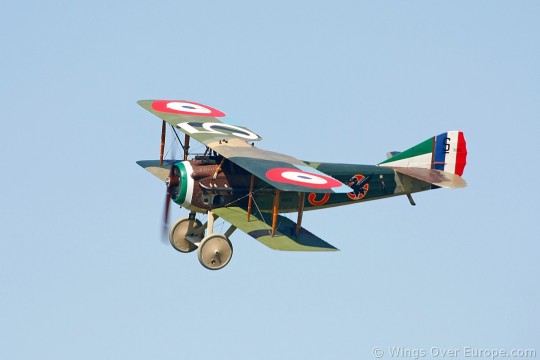
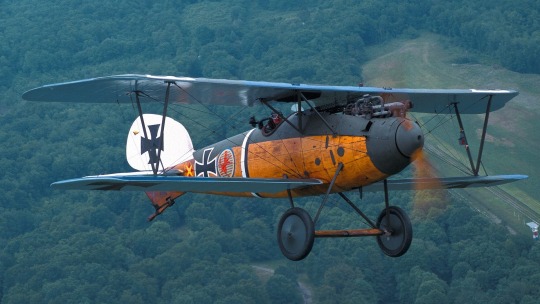

Flying replicas of WW1 biplanes
Sopwith Camel
SPAD S.XIII
Albatros D.V
Royal Aircraft Factory R.E. 8
214 notes
·
View notes
Photo
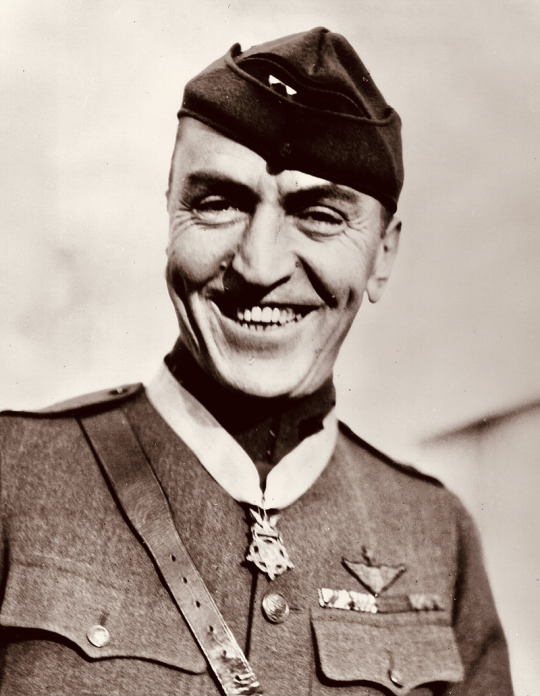
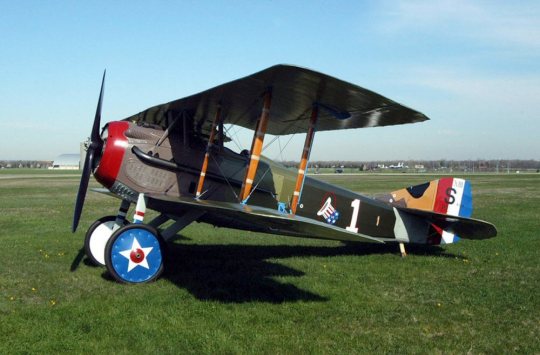
Captain Eddie V. Rickenbacker, American ace fighter pilot and his SPAD S.XIII fighter plane during World War I. Rickenbacker served in the U.S. Air Service in France as commanding officer of the 94th Aero Pursuit Squadron. He shot down 22 enemy planes and four observation balloons. He received the Medal of Honor which he is wearing...
23 notes
·
View notes
Photo

Anxo do sorriso da Catedral de Reims (s.XIII)
10 notes
·
View notes
Photo
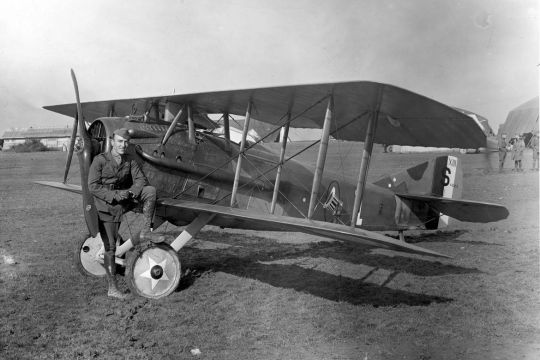
SPAD S.XIII. (Société Pour L'Aviation et ses Dérivés). With Capt. Eddie Rickenbacker. 94th Aero Squadron
225 notes
·
View notes
